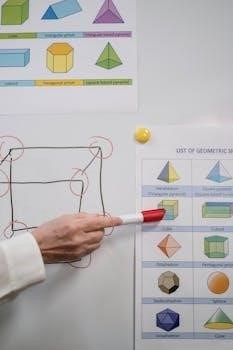Instructional crosswords are a unique way of learning, mixing fun with education. They present subject matter in a puzzle format, engaging students actively. These puzzles can cover various topics, providing a new approach to reinforce learning. This method enhances retention and critical thinking.
What are Instructional Crosswords?
Instructional crosswords are specifically designed educational tools that leverage the familiar format of a crossword puzzle to facilitate learning and knowledge retention. Unlike standard crosswords intended for entertainment, these puzzles are carefully crafted with clues and answers that directly relate to a particular subject or lesson. They serve as an interactive way for students to engage with course material, making the learning process more enjoyable and memorable. The clues might test vocabulary, definitions, facts, or concepts, prompting learners to recall and apply what they’ve been taught. This approach transforms passive learning into active problem-solving, encouraging students to think critically and make connections between different pieces of information. Instructional crosswords are adaptable to various age groups and subjects, ranging from language arts to science and mathematics. They’re not just a game; they’re a purposeful tool for reinforcing understanding and promoting a deeper engagement with the subject matter. The puzzles can be used in class or as homework assignments, providing a versatile method of instruction.

Benefits of Using Crosswords in Teaching
Using crosswords in teaching offers many advantages. They boost student engagement, making learning fun. These puzzles help reinforce vocabulary and improve retention of concepts. Crosswords also promote critical thinking.
Engagement and Fun
Instructional crosswords transform learning into an engaging activity, shifting away from traditional, passive methods. The puzzle format captivates students, making them active participants in the learning process. This element of fun is crucial, as it reduces learning anxiety and fosters a positive association with educational material. The challenge of solving clues and fitting them into the grid provides a sense of accomplishment, further motivating students. Unlike rote memorization, crosswords require active recall and application of knowledge, leading to a more enjoyable learning experience. The interactive nature of these puzzles encourages students to think critically and creatively, rather than simply memorizing facts. This makes learning more interactive, stimulating and memorable for all participants.
Vocabulary Reinforcement
Crosswords are exceptionally effective for vocabulary reinforcement across various subjects. The act of deciphering clues and finding the correct words helps to solidify vocabulary in students’ minds. When learners encounter words in a context they must actively understand and apply them, which enhances retention. This method is particularly useful in language classes, but also benefits science and math, where specific terminology is essential. The interactive nature of crosswords ensures that students are not just passively reading words, but actively thinking about their meanings and usage. The satisfaction of completing a crossword serves as positive feedback, encouraging further vocabulary learning. Repeated exposure to words within a puzzle context aids in long term memory storage, making it a valuable educational technique.

Creating Instructional Crosswords
Creating instructional crosswords involves selecting a topic, crafting suitable clues, and arranging the words into an engaging puzzle grid. There are many tools available to assist educators in making effective crosswords.
Tools for Crossword Creation
Numerous tools are available for creating instructional crosswords, catering to different needs and skill levels. Online crossword generators are popular choices, offering user-friendly interfaces where educators can input words and clues, then customize the grid size and layout. These platforms often provide options for saving, sharing, and even printing the created puzzles. Some tools integrate with learning management systems, making it easy to distribute crosswords to students. Software programs dedicated to puzzle creation offer more advanced features, like complex grid designs, and the ability to incorporate images or other multimedia elements. Educators can also use simple spreadsheet software to manually construct crosswords if they prefer a hands-on approach. The choice of tool often depends on the desired complexity of the crossword, the available time, and the educator’s technical proficiency. Whether online or offline, these tools are designed to simplify and streamline the crossword creation process, enabling educators to focus on designing engaging and effective learning materials.
Tips for Effective Crossword Design
Creating effective instructional crosswords requires careful planning and attention to detail. Start by selecting vocabulary that aligns with the learning objectives, ensuring that the words are relevant and appropriate for the students’ level. Craft clear and concise clues that accurately reflect the target words, avoiding ambiguity or overly complex phrasing. Vary the types of clues used, such as definitions, synonyms, or fill-in-the-blanks, to maintain engagement. Ensure that the crossword grid is balanced and not too dense, allowing for a reasonable challenge without causing frustration. Consider the overall layout of the puzzle, making sure it’s visually appealing and easy to read. Test the completed crossword before using it in class, to identify any errors or areas that might be confusing. Provide clear instructions on how to complete the crossword, especially for students who are new to this type of activity. Remember that the goal is to create a fun and educational experience that reinforces learning, so effective design is key.

Crossword Examples by Subject
Crosswords adapt to diverse subjects, enriching learning. Language crosswords build vocabulary, while science crosswords test concepts. Math crosswords engage numerical thinking. Tailoring content to subjects enhances educational impact.
Language Learning Crosswords
Language learning crosswords are a fantastic tool for vocabulary expansion and reinforcement. They can be designed to focus on specific themes, such as travel, food, or daily routines, providing a context for new words. These crosswords often include clues that are definitions, synonyms, or even short sentences using the target vocabulary. For example, a crossword might ask for “a place to sleep when traveling” with the answer being “hotel”. This approach allows learners to actively recall and apply their knowledge. Furthermore, language crosswords can also aid in grammar practice, by including clues that require the correct verb tense or adjective agreement. They offer a fun and engaging way to learn and test language skills, moving away from rote memorization and towards active application of the language. Crosswords encourage students to think critically about the language they are learning, making the learning process more effective. They also encourage spelling accuracy, which is crucial for written communication skills.
Science and Math Crosswords
Science and math crosswords offer a unique approach to learning complex concepts. In science, they can cover topics from the periodic table to biological processes, helping students recall specific terms and definitions. For instance, a clue might ask for “the chemical symbol for gold,” with the answer being “Au.” These puzzles can also include diagrams or equations as clues, prompting students to apply their knowledge in a different format. Math crosswords, on the other hand, might use numerical or symbolic clues, such as “the result of 7 x 8,” or “a shape with three sides,” requiring students to perform calculations or remember formulas. This format can make learning abstract concepts more tangible and interactive. They help students connect theoretical knowledge with practical application. This active recall of information through puzzles enhances understanding and retention, offering a refreshing change from traditional study methods. They also promote problem-solving abilities, which are critical in both science and math.

Using Crosswords in the Classroom
Integrating crosswords into lessons can boost engagement and offer varied learning experiences; They serve as effective tools for both review and introduction. This method caters to different learning styles, enhancing understanding.
Implementation Strategies
When using instructional crosswords, begin with a clear explanation of the rules, especially for new users. A simple FAQ sheet can be helpful. Consider starting with easier puzzles to build confidence, gradually increasing complexity. Integrate crosswords at different points in your lessons, as a warm-up, review, or a fun break; Use them in individual work or in group settings to promote collaboration. Encourage students to discuss their answers and problem-solving strategies. Crosswords can be assigned as homework to reinforce classroom learning or as in-class activities; Provide feedback on completed crosswords to clarify any misconceptions. You can also gamify the process by setting time limits or awarding points for correct answers. This method fosters engagement and helps assess understanding in a non-intimidating way. Make use of technology by using online tools for creating or solving crosswords as well, to make the process more engaging.
Adapting to Different Learning Levels
Adapting instructional crosswords for different learning levels is essential to ensure all students benefit. For younger learners or those with learning difficulties, use simpler words and shorter clues, focusing on basic concepts. Provide visual aids, such as pictures, alongside the clues for better comprehension. For more advanced learners, challenge them with more complex vocabulary and abstract clues. Increase the length of words and intricacy of the puzzle layout for a greater challenge. Offer variations of the same crossword with varying difficulty levels to cater to diverse abilities in the classroom. Encourage students to create their own crosswords, allowing them to engage with the material at their own pace. Provide hints or partial answers for those who need extra support, gradually reducing assistance as they improve. This approach keeps learning fun and accessible for all learners.
